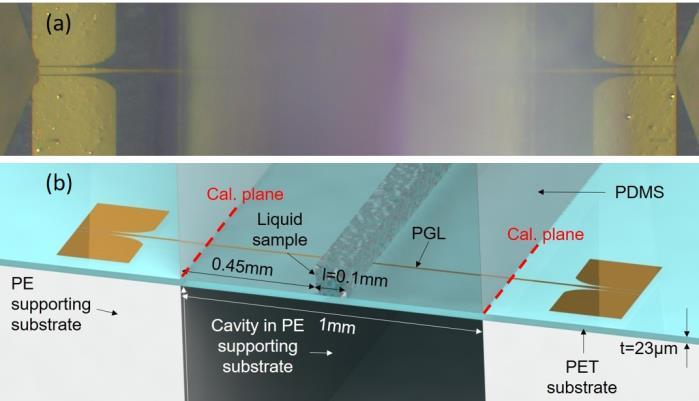
3 minute read
J Cabello Sanchez On chip Frequency Domain Terahertz Spectroscopy of Liquids
Juan Cabello-Sánchez, Vladimir Drakinskiy, Jan Stake and Helena Rodilla Chalmers University of Technology, 412 96 Gothenburg, Sweden
Advertisement
Abstract— Terahertz spectroscopy of liquid samples is critical for analysing biomolecules in their native environment. However, the high losses due to strong water absorption can severely limit the sensitivity of the measurements. Here, we present S-parameter measurements for on-chip terahertz spectroscopy of highly lossy aqueous solutions between 0.75–1.1 THz. Results show a high signal-to-noise ratio (30 dB) compared to other on-chip methods, enabling detection of changes in complex refractive index as low asΔn = 0.02, andΔ = 0.003 inhighly lossy aqueousenvironments. These results prove terahertz frequency-domain spectroscopy as a sensitive on-chip method for measuring small dielectric changes in high-loss aqueous solutions up to 1.1 THz, making a step towards integrated, sensitive, and traceable measurements of biomolecules in their natural environment.
I.INTRODUCTION
SPECTROSCOPY at terahertz (THz) frequencies has shown to be a useful method for studying biomolecular dynamics [1], in which water places a key role [2]. However, aqueous solutions present very high losses at THz frequencies (around 1000 dB/cm), which deteriorates the signal-to-noise ratio of the measurements, affecting the sensitivity [3].
A promising method for achieving higher sensitivity than traditionally used THz-TDS is S-parameter measurements using vector network analysers (VNA)—frequency-domain spectroscopy. This method is based on electronic heterodyne technique, that benefit fromincreased frequencyresolution, and signal-to-noise ratio, at the expense of narrower bandwidth analysis. In this paper we present on-chip THz spectroscopy measurements of isopropan-2-ol/water mixtures, measured with vector network analyser, and contact probes.
II.RESULTS
To characterise the samples, we used a planar Goubau line (PGL) integrated with a micro fluidic channel (Fig. 1). The PGL was designed to have ultra-low losses, by fabricating it on a thin—23 µm—polyethylene terephthalate substrate which avoided radiation losses by being suspended in air.
We measured the S-parameters from 0.75 THz to 1.1 THz of the 1 mm long PGL with the microfluidic channel containing isopropan-2-ol/water samples. To compute the real and imaginary part of the samples’ refractive index (Fig. 2), we processed the S-parameter measurements with a recently developed general line-line method [4], and compared them to electromagnetic simulations results. The extracted refractive index shows that increases in the isopropan-2-ol concentration causes a consistent decrease in both the real and imaginary part of the samples’ refractive index, as expected from the refractive index values of isopropan-2-ol and water.
The results show that on-chip THz frequency-domain spectroscopy measurements—with a typical high signal-tonoise ratio higher than 30 dB—can detect small changes of refractive index in highly lossy aqueous environments. In contrast, similar attempts using on-chip time-domain spectroscopy around 1 THz, could not resolve measurements of samples.

Fig. 1. (a) Micrograph of the planar Goubau lines during the sample measurements. (b) Sketch showing a cross-section of the PDMS microfluidic channel—containing the liquid samples—intersecting with the planar Goubau line.
Fig. 2. The high SNR of the measurements allows detection of small
refractive index differences. Measured (a) real and (b) imaginary part of the refractiveindexoftheisopropan-2-ol/watersamples.Pureisopropan-2-ol(IPA) is taken as a reference measurement.
REFERENCES
[1] A. Markelz, S. Whitmire, J. Hillebrecht, and R. Birge, “THz time domain spectroscopy of biomolecular conformational modes,” Phys. Med. Biol., vol. 47, no. 21, pp. 3797–3805, 2002. [2] Y. Xu and M. Havenith, “Perspective: Watching low-frequency vibrations of water in biomolecular recognition by THz spectroscopy,” J. Chem. Phys., vol. 143, no. 17, 2015. [3] M. Swithenbank et al., “On-Chip Terahertz-Frequency Measurements of Liquids,” Anal. Chem., vol. 89, no. 15, pp. 7981–7987, Aug. 2017. [4] X. Bao et al., “A General Line-Line Method for Dielectric Material Characterization Using Conductors with the Same Cross-Sectional Geometry,” IEEE Microw. Wirel. Components Lett., vol. 28, no. 4, pp. 356–358, Apr. 2018.









